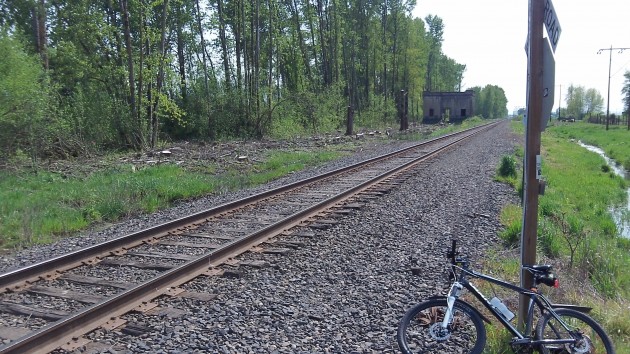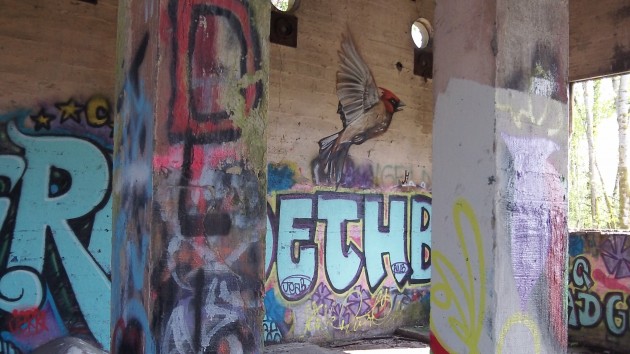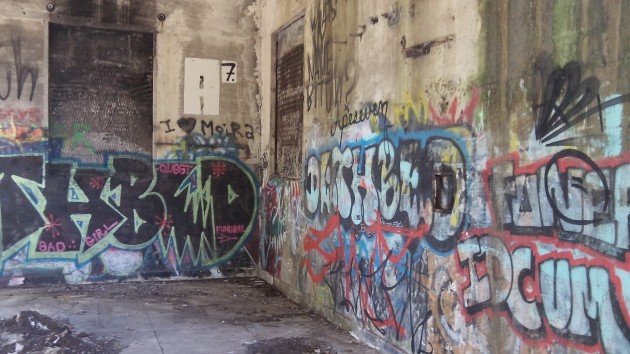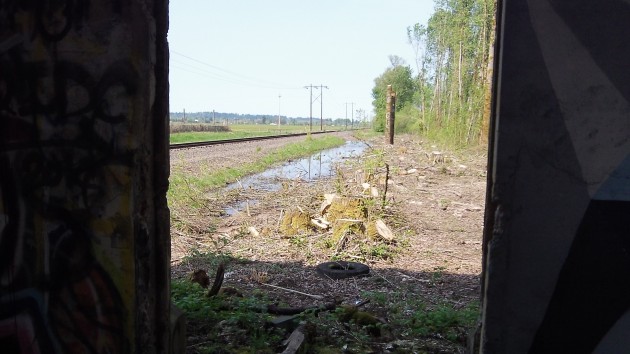The Pirtle transfer station of the old Oregon Electric Railway used to be half-hidden by tall trees. Now the trees — cottonwoods, I think — have been mostly cut down, and this concrete relic of our railroad history stands out there in plain view about 150 yards south of Pirtle Drive.
It’s not as though graffiti vandals had not known the place was there before. They’ve been defacing the walls and piling trash on the floor for many years, decades probably.
A hundred years ago the building housed generating equipment to send power into the OE’s overhead lines, but only the concrete walls, floor and roof remain.
The Oregon Electric opened its line from Portland to Salem in 1907. Five years later, when it extended the track through Albany to Eugene in 1912, it tried to cut costs by powering the wires at 1,200 instead of 600 volts. Doubling the voltage enabled the company to space transfer stations including Pirtle 18-20 miles rather than 12 miles apart.
Somewhere south of Pirtle (named for land owner Grant Pirtle, according to Oregon Geographic Names), at a point called Gray, the OE built a spur to Corvallis, ending at the Linn County side of the Van Buren Avenue bridge. Later, when passenger service died, the railroad abandoned the spur and dug up the track. On the main Oregon Electric line too, business went from bad to worse. Crew members often outnumbered passengers, and by 1932, there was only one train a day to Eugene. Passenger service ended on May 13 that year.
(I got all this from The Transfer, the newsletter of the Oregon Electric Railway Historical Society, and a 1979 publication put out by the Horner Museum in Corvallis.)
What puzzles me now is the logging that exposed the Pirtle station to full view from Pirtle Drive. I guess the trees were cut to keep them from falling across the tracks and disrupting the Portland & Western’s freight operations. But why leave four bare trunks, two each both north and south of the station?
It would be nice for somebody to take an interest in this wreck of a power station and clean it up, though it’s hard to see to what possible use the structure could be put. It’s not, as far as I can tell, on any public right of way. To get there, you have to trespass on the railroad tracks or other private land.
Still, it’s an object of interest. The building is at least 103 years old and if nobody tears it down, it might last 500 more. (hh)





Ah, yes….Back in the early 70’s many of us Albany teens used that site for ordinary “youthful indiscretions” common to those times. It used to be pretty well obscured by blackberry vines and alders and none of my crowd explored the inside as it was pretty well secured in addition to the Himalayan blackberries that stood guard. Though it was obviously railroad related, we always wondered exactly why it was built and it’s purpose. So, to quote a famous late broadcaster: “Now, we know the rest of the story.” Thanks Hasso!
Thanks Hasso, I nice piece of history.
Thanks for this story. I’m making a copy for the Linn County Historical Museum’s archives. We are always delighted to be able to add little known tidbits of county history to our files
There is an old article in the Democrat Herald about why the trees are being cut down:
http://democratherald.com/news/local/power-line-project-will-down-thousands-of-trees/article_ad86f374-7c8b-11e1-a5e6-0019bb2963f4.html
You might contact the article’s author for more information… ;)
Right. I remember writing that story in April 2012, and the project was to be done that summer.
Can’t believe this logging operation three years later is part of the same deal. (hh)
I have not seen any Cottonwoods cut down until recently. I noticed that they were cut south of HWY 34 only a month or two ago. This is the BPA we are talking about after all……
Cutting in our section of the track started in the summer / autumn of 2013. The story in our area was that the contracting company experienced a work fatality on another project on the coast and shut down this job too for administrative reasons. It resumed last summer.
Again from neighbors, I was told that they left the bare trunks as habitat for wildlife. I would be skeptical except that I once cut some poplars (when I was growing up we called them Bam trees) of about telephone pole dimensions and planted them in the ground as supports for raised platform as a “tree house” for my children. The dang things took root and grew ! I have since learned that poplars aren’t dead until they have been turned to ashes.